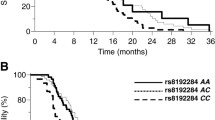Abstract
Background and Objective: Interleukin (IL)-10 is a pleiotropic cytokine that can both stimulate and suppress the immune response. Previous studies have reported that IL-10 production was significantly elevated in cachectic patients, and it has been confirmed that polymorphisms of the IL10 gene could influence its expression. Therefore, we designed this study to investigate whether polymorphisms of the IL10 gene were associated with cachexia in patients with low-third gastric cancer in a Chinese population.
Methods: 190 patients with low-third gastric cancer were included in this study. The serum levels of IL-10 were measured by radioimmunoassay. The single nucleotide polymorphisms (SNPs) at positions -1082A/G, -819T/C, and -592A/C in the IL10 gene promoter were analyzed using polymerase chain reaction (PCR) restriction fragment length polymorphism (PCR-RFLP).
Results: The serum levels of IL-10 were significantly higher in patients with cachexia than in those without (Z = −10.66, p<0.001). Single SNP analysis showed that the frequency of the IL10 -1082G allele was increased in patients with cachexia (p = 0.02). The -1082AG and -819CC genotypes were observed to be associated with an increased risk of cachexia. In a logistic regression analysis adjusted for actual weight and carcinoma stage, the -1082AG genotype was associated with an odds ratio (OR) of 2.45 (95% CI 1.21, 4.96; p = 0.01), and the -819CC genotype was associated with an OR of 3.70 (95% CI 1.20, 11.39; p = 0.02) for cachexia. Furthermore, haplotype analysis of the -1082A/G, -819T/C, and -592A/C SNPs revealed that at least five haplotypes (ATA, ACC, GCC, ACA, and ATC) were present in this Chinese population, and the -1082G/-819C/-592C (GCC) haplotype was associated with a significantly increased risk of cachexia as compared with the ATA haplotype (OR = 2.42; 95% CI 1.17, 5.00; p = 0.02).
Conclusion: Our results indicate that genetic polymorphisms of IL-10 may influence susceptibility to cachexia in patients with low-third gastric cancer in this Chinese population.






Similar content being viewed by others
References
Tan BH, Deans DA, Skipworth RJ, et al. Biomarkers for cancer cachexia: is there also a genetic component to cachexia? Support Care Cancer 2008; 16: 229–34
Dianliang Z. Probing cancer cachexia-anorexia: recent results with knockout, transgene and polymorphisms. Curr Opin Clin Nutr Metab Care 2009 May; 12(3): 227–31
Inui A. Cancer cachexia-anorexia syndrome: current issues in research and management. CA Cancer J Clin 2002; 52: 72–91
Ryan JL, Carroll JK, Ryan EP, et al. Mechanisms of cancer-related fatigue. Oncologist 2007; 12: 22–34
Pirlich M, Norman K, Lochs H, et al. Role of intestinal function in cancer. Curr Opin Clin Nutr Metab Care 2006; 9: 603–6
Argiles JM, Busquets S, Garcia-Martonez C, et al. Mediators involved in the cancer anorexia-cachexia syndrome: past, present, and future. Nutrition 2005; 21: 977–85
Zheng YB. Cancer cachexia and cytokines. J Int Oncol 2006 January; 33(1): 29–32
Shibata M, Nezu T, Takekawa M, et al. Serum levels of interleukin-10 and interleukin-12 in patients with colorectal cancer. Ann N Y Acad Sci 1996 Oct 31; 795: 410–2
Deans DA, Tan BH, Ross JA, et al. Cancer cachexia is associated with the IL10 -1082 gene promoter polymorphism in patients with gastroesophageal malignancy. Am J Clin Nutr 2009; 89: 1164–72
Mocellin S, Marincola FM, Young HA. Interleukin-10 and the immune response against cancer: a counterpoint. J Leukoc Biol 2005; 78: 1043–51
Kingo K, Ratsep R, Koks S, et al. Influence of genetic polymorphisms on interleukin-10 mRNA expression and psoriasis susceptibility. J Dermatol Sci 2005; 37: 111–3
Turner DM, Williams DM, Sankaran D, et al. An investigation of polymorphism in the interleukin-10 gene promoter. Eur J Immunogenet 1997; 24(1): 1–8
Fearon KC, Voss AC, Hustead DS, Cancer Cachexia Study Group. Definition of cancer cachexia: effect of weight loss, reduced food intake, and systemic inflammation on functional status and prognosis. Am J Clin Nutr 2006 Jun; 83(6): 1345–50
UICC 2002. Sobin LH, Wittekind CH. TNM classification of malignant tumors. 6th ed. New York: Liley-Liss, 2002: 52–6
Costa GC, da Costa Rocha MO, Moreira PR, et al. Functional IL-10 gene polymorphism is associated with Chagas disease cardiomyopathy. J Infect Dis 2009 Feb 1; 199(3): 451–4
Edwards-Smith CJ, Jonsson JR, Purdie DM, et al. Interleukin-10 promoter polymorphism predicts initial response of chronic hepatitis C to interferon alfa. Hepatology 1999 Aug; 30(2): 526–30
Biostatistics and Bioinformatics Unit, Catalan Institute of Oncology. SNPStats: your web tool for SNP analysis [online]. Available from URL: http://bioinfo.iconcologia.net/index.php?module=Snpstats [Accessed 2010 Mar 9]
Poli F, Nocco A, Berra S, et al. Allele frequencies of polymorphisms of TNFα, IL-6, IL-10 and IFNG in an Italian Caucasian population. Eur J Immunogenet 2002; 29(3): 237–40
Perrey C, Pravica V, Sinnort PJ, et al. Genotyping for polmorphisms in interferon-γ, interleukin-10, transforming growth factor-β1 and tumour necrosis factor-α gene: a technical report. Transpl Immunol 1998; 6(3): 193–7
Du R, Pan SY, Lu BX. Allele frequencies of polymorphisms of interleukin-10 promoter in Chinese Han population. Chinese Journal of Anatomy 2006; 29(6): 686–9
Moraes MO, Santos AR, Schonkeren JJ, et al. Interleukin-10 promoter haplotypes are differently distributed in the Brazilian versus the Dutch population. Immunogenetics 2003; 54: 896–9
Wu MS, Wu CY, Chen CJ, et al. Interleukin-10 genotypes associate with the risk of gastric carcinoma in Taiwanese Chinese. Int J Cancer 2003; 104: 617–23
Acknowledgments
This study was supported, in part, by grants from Shandong Natural Foundation (Y2006C20) and the Key Project of Shandong Scientific and Technology (2008GG30002034). The authors have no conflicts of interest that are directly relevant to the content of this study.
Author information
Authors and Affiliations
Corresponding author
Rights and permissions
About this article
Cite this article
Sun, F., Sun, Y., Yu, Z. et al. Interleukin-10 Gene Polymorphisms Influence Susceptibility to Cachexia in Patients with Low-Third Gastric Cancer in a Chinese Population. Mol Diag Ther 14, 95–100 (2010). https://doi.org/10.1007/BF03256358
Published:
Issue Date:
DOI: https://doi.org/10.1007/BF03256358




